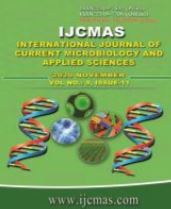


 National Academy of Agricultural Sciences (NAAS)
National Academy of Agricultural Sciences (NAAS)

|
PRINT ISSN : 2319-7692
Online ISSN : 2319-7706 Issues : 12 per year Publisher : Excellent Publishers Email : editorijcmas@gmail.com / submit@ijcmas.com Editor-in-chief: Dr.M.Prakash Index Copernicus ICV 2018: 95.39 NAAS RATING 2020: 5.38 |
In India, detopping of onion is carried out mostly by manual operation after uprooting of the onions which is tedious and time consuming. In this study, laboratory evaluation of mechanized detopping unit was demonstrated before uprooting the onions. The crop was grown in plastic trays with spacing of 20 x 12cm. The detopping unit consists of vertical shaft attached with cutting thread at the bottom end. Reinforced composite nylon material was chosen as cutting material due to its extra strength and high resistance to breakage. The nylon thread detops the onion leaves in rotary cutting as line trimmers. Based on the cross sectional area, three different types of threads (square -T1, round - T2 and flat with one side serrated - T3) were selected for evaluation of detopping unit. The detopping unit was evaluated at three levels of peripheral speed (5.31- N1, 6.64 - N2 and 7.97 m s-1 - N3) of the unit, and three forward speeds (1 - S1, 1.5 - S2 and 3.4 kmph - S3) using sticky belt. The better performance of detopping onion was observed in square shaped cross-sectional type (T1) nylon string with both four strings and eight strings (H2 andH3) for the average onion neck length of 23 mm and it was sufficient for minimising storage losses of onions. The optimum peripheral speed of detopping unit was observed as 6.64 m s-1 with forward speed of 1 kmph.
 |
 |
 |
 |
 |